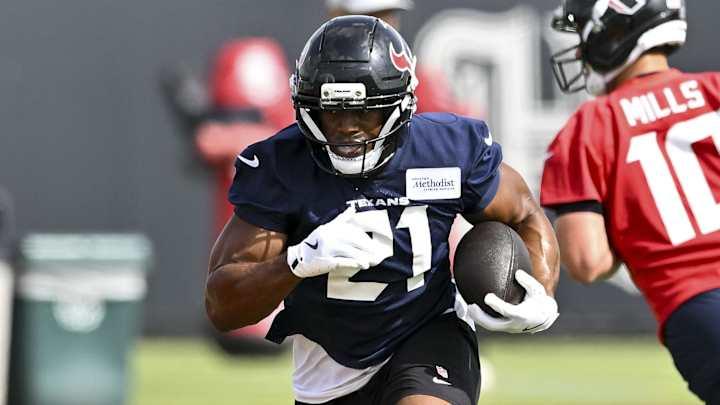Nick Chubb Emerges as Houston Texans’ Primary Rusher Following Mixon’s Injury
In light of Joe Mixon’s recent injury, the Houston Texans have elevated veteran Nick Chubb to the forefront of their rushing attack. Chubb’s blend of power and agility injects much-needed stability into a ground game that has faced inconsistency this season. Known for his ability to break tackles and generate yards after contact, Chubb’s presence offers the Texans a renewed offensive weapon as they aim to improve their standing in the competitive AFC South.
Factors fueling Chubb’s rise to lead back:
- Multiple seasons surpassing 1,000 rushing yards, showcasing reliability
- Exceptional pass-blocking skills that bolster Houston’s aerial offense
- Veteran leadership that supports the development of younger backs on the roster
| Running Back | Average Yards Per Carry | Rushing Touchdowns |
|---|---|---|
| Nick Chubb | 5.0 | 9 |
| Joe Mixon (Injured) | 4.3 | 6 |
Evaluating Chubb’s Influence on Texans’ Offensive Strategy and Play Design
Nick Chubb’s promotion to lead running back has prompted a notable transformation in Houston’s offensive blueprint. With Mixon out of action, the Texans have adjusted their rushing schemes to leverage Chubb’s downhill running prowess and sharp field vision. Recent game footage highlights a surge in inside zone runs and power rushes aimed at exploiting Chubb’s quick burst through defensive gaps. This shift not only eases pressure on the quarterback but also enhances play-action passing opportunities, which were less frequent under Mixon’s more versatile but situational running style.
Beyond rushing plays, Houston’s offense has integrated innovative formations and motion tactics tailored to Chubb’s strengths, aiming to confuse opposing defenses accustomed to Mixon’s presence. Key tactical changes include:
- More frequent use of two-back sets pairing Chubb with a pass-catching specialist
- Variable tempo adjustments to disrupt defensive rhythm
- Increased deployment of screen passes and quick outlets to capitalize on Chubb’s yards-after-catch ability
| Play Type | Usage Before Mixon Injury | Usage After Chubb Promotion |
|---|---|---|
| Inside Zone Runs | 33% | 52% |
| Play-Action Passes | 18% | 28% |
| Screen Passes to RB | 12% | 20% |
Optimizing Chubb’s Talents for Upcoming Matchups
To harness Nick Chubb’s full potential in the wake of Joe Mixon’s injury, the Texans should emphasize a multifaceted rushing attack that balances power runs between the tackles with outside stretch plays. This approach will exploit Chubb’s combination of strength and agility, enabling him to consistently find and extend running lanes. Incorporating creative play designs such as draws, screens, and mismatches against linebackers can further amplify his impact.
Moreover, expanding Chubb’s role in the passing game will transform him into a dual-threat asset. Recommended strategies include:
- Utilizing check-downs and wheel routes to capitalize on his speed and yards-after-catch prowess
- Implementing play-action rollouts to create open space and confuse defenders
- Deploying screen passes and outlet options to keep defenses honest and prevent box stacking
This balanced offensive scheme, blending brute force with finesse, will position Chubb as a cornerstone of Houston’s attack, especially in high-pressure situations like red-zone drives and third-down conversions.
| Tactical Approach | Focus Area | Anticipated Outcome |
|---|---|---|
| Diverse Running Schemes | Blend Inside Power & Outside Stretch Runs | Enhance Yards After Contact |
| Dual-Threat Utilization | Route Running & Screen Passes | Disrupt Defensive Schemes |
| Situational Play Calling | Focus on Third-Down & Red-Zone Scenarios | Improve Conversion Efficiency |
Long-Term Consequences for Texans’ Running Back Depth and Roster Strategy
Joe Mixon’s injury has triggered a pivotal re-evaluation of the Houston Texans’ backfield depth and future roster planning. Nick Chubb’s elevation to lead back spotlights both the team’s immediate reliance on his skill set and the pressing need to strengthen depth behind him. This scenario presents both a challenge and an opportunity for the Texans’ coaching staff and front office to recalibrate their personnel strategies.
Looking ahead, Houston must prioritize acquiring and nurturing versatile running backs who can contribute across multiple facets of the game, including special teams and passing situations. Additionally, reinforcing the offensive line will be critical to unlocking the full potential of the rushing attack. Key roster considerations include:
- Securing young, high-upside talent to provide dependable depth and future starters
- Targeting multi-dimensional backs capable of excelling in both rushing and receiving roles
- Investing in offensive line improvements to enhance run-blocking efficiency and protect ball carriers
| Running Back | Current Role | Contract Status |
|---|---|---|
| Nick Chubb | Lead Back | 3 Years Remaining |
| Backup RB 1 | Secondary Ball Carrier | Restricted Free Agent |
| Rookie Prospect | Developmental Role | Rookie Contract |
Conclusion
As the Houston Texans gear up for the remainder of the NFL season, Nick Chubb’s rise to the lead running back role represents a critical turning point in their offensive approach following Joe Mixon’s injury. This transition tests the team’s depth and adaptability, placing a spotlight on Chubb’s ability to seize the moment and become a central figure in Houston’s offensive identity. Fans and analysts will be keenly observing how the Texans adjust to this challenge and whether Chubb can solidify his status as a key contributor moving forward.




